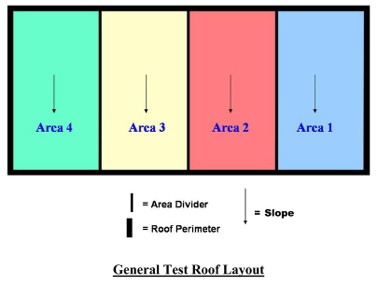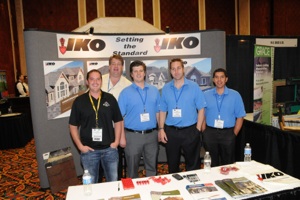The following update describes the 10-year roof
survey highlights of the findings from the field
regarding WSRCA’s TPO Research and Testing
Project, which WSRCA has conducted with four
different TPO roofing membranes, its participating
contractors, and with the participation of three
U.S. TPO roofing manufacturers.
Brief Background
Over the last decade, in a concerted effort
to learn more about the weathering characteristics
of TPO (thermoplastic polyolefin) single-ply roof
membranes, WSRCA has conducted an in-situ roof
research and testing program. The program
consists of what may be referred to as “weathering farms” utilizing four, full-scale, test roofs, each divided into four sections in order to incorporate the four TPO roofing membranes and allow study of the effects of real-world weathering on TPO membranes in four distinctly different climate regions in Western North America.
The TPO roof membranes were installed during 2000-2001 and have been periodically inspected and tested over the intervening years. The last round of roof inspections occurred during 2010-2011 in what is considered to be the tenth-year of aging of these membranes. Note that the roofs were not all installed on the same date, and as such some have aged slightly longer (i.e., months) than others. For more background information please refer to Western States Roofing Contractors Association’s TPO Weathering Farm Project 7th-Year Survey Report published in Western Roofing, Siding, and Insulation magazine in May, 2010, or 5th-Year Survey published in Roof Consultants Institute’s Proceedings of the RCI 21st International Convention in March 2006, or 3rd-Year Survey published in Western Roofing magazine in March 2006, or 1st-Year Survey published in Western Roofing magazine in May 2000.
WSRCA TPO Weathering Farm Test Roof Locations
The locales and climates are: Anchorage, Alaska, generally cold and damp; Seattle, Washington, generally moderate with wet and dry periods; Las Vegas, Nevada, generally hot and dry; San Antonio, Texas, generally hot and humid. On-Roof Weathering and Testing is Unbiased, All Materials Are Blind-labeled: The TPO membranes were blind-labeled, and laid out similarly in each of the four test roofs.
General Highlights
This TPO roofing research project is now in its eleventh-year of weathering with all roofs having aged for approximately ten years, with San Antonio and Anchorage a few months less than ten years, Las Vegas just over ten years and Seattle a full eleven years. Four U.S. based TPO roofing manufacturers supplied 60-mil thick, white colored TPO roofing, flashings, and accessories to each of the four sites, for installation by WSRCA member roofing contractors, on buildings of private ownership whose roofs were donated by their owner(s) for this project. Three of the buildings were new construction configurations, and one building, the San Antonio site, was an existing building.
All of the roofs are mechanically attached systems, but not all the roofs are the same construction. In Seattle, the polyisocyanurate insulated TPO membrane roofing system is installed over wood panel roof decks, and there is a section of each of the four TPO roof areas that extend beyond the insulated exterior walls to cover a large canopy over loading areas where each of the four TPO membranes were applied without rigid insulation, so as to be able to compare insulated and non-insulated roof performance. In Anchorage and Las Vegas the polyisocyanurate insulated TPO roof systems are installed over steel panel roof decks. In San Antonio the roof deck is steel, but due to lack of availability of a new construction building at that time, the TPO roof system is a recover roof applied over a gypsum-based cover board, which was installed over an existing single-ply PVC roof membrane.

Based on the recent round of visual and tactile roof surveys (e.g., roof inspections), all of the roofs are performing, with fifteen (15) of the sixteen (16) membranes performing very well at each of the four different climatic sites. One (1) of the four TPO roof areas in Las Vegas, Nevada has experienced problems with creases that have recently cracked or split the top coating over the reinforcing scrim.
In general, hot-air welded seams continue to perform well at all four of the sites. Relatively extensive probing of side and end lap seams, and TPO flashings, was performed in the field of all the roof areas during the 10th-year inspections, and with just a few exceptions on one of the roof areas in Las Vegas, disbonded seams were not discovered. Small voids or disbonded areas were found at hand welded locations, and at robotic-weld start and stop points, at a few seam locations in Las Vegas and San Antonio. There were also a few disbonded locations found at various pre-molded boot flashings, and a few at T-joint covers/patches in the field of roof areas. All disbonded locations were marked and subsequently repaired. All roofs are presently leak-free, and all but one of the sixteen 60-mil white TPO membranes continues to show good in-service performance.
With this WSRCA TPO project now coming to a close, it is important to acknowledge the great cooperation from all the participants, including:
•The Participating Contractors: Snyder Roofing, Kyle King and Tim Gardner of Snohomish, Washington; Rain Proof Roofing, Pat Reilly and Misty Stoddard of Anchorage, Alaska; American Roofing and Metal Co. Inc., Eddie Spalten and Richard Higgs of San Antonio,Texas; and Commercial Roofers, Inc., Dennis Conway and Ray Snow of Las Vegas, Nevada.
•The Participating Manufacturers (in alphabetical order): Carlisle SynTec, with project representative, Randy Ober; Firestone Building Products, represented by Dwayne Wacenske; Dow Roofing Systems, Formerly Stevens Roofing Systems, which, as of February 2011, has discontinued the TPO line and withdrew from the Project; and GenFlex Roofing Systems, who withdrew during 2007.
•WSRCA’s TPO Task Group: KC Barnhardt, WSRCA Former President Chuck Chapman, WSRCA Immediate Former President Christian Madsen, WSRCA Current President Travis Nelson, WSRCA Senior-Vice President Don Fry, Associate, WSRCA Chairman Steep-slope Committee, Michael Ludwig, Darrell Hunt, Bill Collins, and Stephen Elliott, Technical Research Associates; and Jim Carlson, WSRCA’s Technical Advisor.
Along with skilled laboratory testing and experienced roof research personnel from the National Research Council of Canada (Institute for Research in Construction): Ana H. Delgado, Research Council Officer, Building Envelope and Structure; and Dr. Ralph M. Paroli, Director, Building Envelope and Structure.
•Required Cooperation: The joint TPO Task Group worked together, complementing each other by filling the voids in each other’s knowledge and experience base. In this way the project has been kept on track in an unbiased manner. It is believed that this is the largest joint in-situ roof research and testing project ever taken on publicly by the roofing contractor sector of the industry, with approximately 470 squares of TPO roofing being installed, regularly monitored, and performance reported to the entire North American roofing industry.
10th-Year Survey Findings from the Field
•Seam Integrity: In general, all of the TPO membranes examined in the field to date have proven to maintain their seam quality. All hot-air welded seams, which are randomly probed during the inspections, are proving to have generally good weld integrity. Some isolated voids were found during the final, 10th-year inspections, which were repaired during the survey by personnel from the participating local roofing contractor.
These types of issues after 10-plus years appear to be relatively normal occurrences for single-ply roof membranes where there are hand-welded seams, and those partially fused or bonded locations examined appear to be attributable to minor cold weld locations during application. All robotic welds probed on all four of the test roofs were found to be intact and well fused.
•Membranes Tightening: Although during previous years’ field inspections and data collection, some tightening of the sheets, visible at some locations as slight bridging at roof-to-wall intersections and some roof-to-area divider transitions appeared to have gradually increased, this trend seems to have lessened after the seventh- year, with only a few areas now showing very slight increases of this condition.
•Weldablility: A new factor, not observed in previous year’s inspections, was identified at some locations in the 10th-year roof survey. In the past years’ inspections, patching of test cuts and execution of repairs was accomplished with a basic membrane preparation consisting of cleaning with a diluted-detergent solution (e.g., a trisodium phosphate {TSP} containing, non-sudsing, low-residue detergent) and a medium-bristle scrub brush or push broom, followed by a clean water rinse, and squeegee dry, and repeated where needed to remove stubborn surface dirt, dried debris, and tenaciously adhered organic accumulation. Per good thermoplastic single-ply roofing practice the detergent scrubbing and clean water rinsing, was always followed by a solvent wipe with a clean rag wetted with the Manufacturer’s recommended solvent. This preparation proved to not be sufficient at some locations during the 10th-year survey and a “solvent-scrub” step was added to the preparation procedure utilizing a common kitchen scouring pad wetted with solvent to more aggressively remove a layer of oxidization on the surface of one of the aged membranes. In one location it was necessary to use synthetic steel wool and solvent before a proper, well-fused weld could be achieved to the topside of the weathered roof surface.
When preparing aged single-ply membranes for repairs, the repair persons should be aware that aggressive scouring is sometimes needed to prepare the roof to accept the repair welds but overly aggressive solvent scouring can be harmful as it can remove too much of the surface of the existing membrane. The topic of preparing and welding aged TPO is discussed at length in an article, titled: Welding ‘Aged’ TPO Membrane, by Randy Ober of Carlisle SynTec in the September/October 2007 issue of Western Roofing Magazine.
Clearly, this 10th-year round of roof inspections show that this issue can begin around the 10th-year of the aging process in some TPO membranes. Membrane preparation procedures as well as other TPO repair protocols can be found in the new WSRCA TPO Repair and Maintenance Guidelines. There were locations where the more aggressive preparation protocol was required during the 10th-year test cut repairs, in order to achieve a thorough weld, but it varied at the different test locations. For example: in Anchorage good welds were achieved without the more aggressive solvent scouring method at all four TPO roof areas. In San Antonio the more aggressive method was needed at all four roof areas. In Las Vegas, only Roof Area 2 required the more aggressive method, and in Seattle, Roof Areas 1, 2, and 4 required the more aggressive method.
This variation in surface preparation indicates that in-situ weathering and exposure involves more than simple aging of the different membranes. The type of TPO formulation, degree of oxidization, and surface hardening may be among the numerous other factors. It may be that the lower exposure to solar heat loading and UV radiation in Anchorage, due to snow coverage generally over several months each year, and sun angle, has allowed less weathering degradation, oxidization, and hardening to occur. Whereas the sun load and climate in Las Vegas and San Antonio are quite different than Anchorage, perhaps more degrading weather conditions for TPO, and thus some needed more preparation attention prior to welding. However, the fact that surface preparation conditions were more involved in Seattle, than in Las Vegas, does not allow for a simple or sole conclusion to be reached regarding climate, and/or degree of sun exposure, as a principle factor in membrane weldability changes over time.
•Condensation: During 10th-year inspections at Seattle and Anchorage, moisture from condensation was found under the single-ply membranes at both of these roofs.
The roof survey at the Seattle Roof took place when the air temperature in the earlier part of the day was below freezing and there was ice on the surface of the roof membrane in isolated locations. The test cut taken on Seattle’s Roof Area 1 revealed light moisture accumulation present on the underside of the membrane and in the fiberglass facer of the underlying polyisocyanurate foam insulation. Further investigation revealed that the insulation core remained dry except for the facer, and the underlying plywood roof deck panels were also found to be dry.
Roof Area 1 in Seattle is over the occupied office portion of the building and the interior spaces are heated during business hours during the cooler months of the year. Typical of numerous (i.e., thousands) of mechanically attached single-ply, roof systems, no vapor retarder is present between the plywood roof sheathing or roof deck and the rigid roof insulation.
In Anchorage, the inspection took place in April 2011, shortly after the weather had warmed up enough to melt the snow from the roof. Condensation moisture was found under the membrane and in the facer of the insulation at the Penthouse Roof, which is over conditioned/heated interior space. The Anchorage roof areas do have a 4-mil polyethylene sheeting vapor retarder installed, but the sheeting is discontinuous at the divider walls and does not extend above the level of the insulation at perimeter walls. As a result, vapor drive occurring along the divider walls and perimeters, and/or interior air leaks are allowing warmer, moisture-laden interior air to enter the roof assembly. In either case did it not appear that the amount of condensation moisture was yet significant or causing damage to substrates. However, the presence of moisture is of serious concern to the authors, and brings the subject of vapor retarders back to remind manufacturers, architects and roof designers, as well as contractors, that prudent vapor retarder practices cannot be overlooked, especially in mechanically-attached single-ply systems in cool climates. It is very likely that if the vapor retarder were continuous at the Anchorage location, the condensation moisture would not be present. It also appears likely that had a vapor retarder been installed at the Seattle location, at least at Roof Area 1, which is over occupied office space, condensation moisture would not be present.
Although not generally required by building codes during original roof installation, it is prudent to consider, design, and install a continuous vapor retarding membrane on the warm side of roof assemblies over occupied/heated space in many Western climate regions. As plastic sheeting can easily be damaged by the welding process necessary to install TPO membrane base flashings, it may be appropriate on new TPO roof installations to form the deck-to-wall portions of a vapor retarder membrane system from 45-mil TPO, or other vapor retarder material(s), and use polyethylene sheeting with taped seams in the field of the roof.
•Walk Pads: As was previously reported, after the 7th-Year Roof Surveys, some of the TPO walk pads on the San Antonio test roof areas were found to be weather degraded. These conditions have worsened in the intervening time, and at some locations the walk pads were observed to be so deteriorated that the wind-blown shreds had accumulated in piles.
The participating manufacturers report the previous walk pads have been discontinued, and those currently on the market are a much-improved compound with enhanced weatherability.
•Effects of Hard Creases in Membrane: In the 7th -Year Roof Surveys a small surface crack through the upper portion (i.e., top coating) of the membrane was observed during the inspection of Roof Area 2 at the San Antonio, Texas roof. The crack occurred at a location where the membrane had originally been creased during installation. The crack was repaired during the inspection and no additional damage or crease type issues were observed in San Antonio during the 10th-Year inspection. However, during the 10th-Year inspection a similar but far more extensive cracking and splitting is occurring along creases of Roof Area 2 at the Las Vegas roof.
TPO is generally stiffer in nature than other singly-ply membranes and will tend to not lay back out of the way on it’s own to allow fastening of the underlying sheet along a seam. As a result, during the time, circa 2000 and 2001, of installation, it was common for some applicators to fold back the membrane and to crease it or to place weight on the fold to hold the membrane back. WSRCA and some manufacturers recognized this may cause problems with TPO membranes, thus they have recommended not creasing the membrane. It is recommended that the membrane be laid back and billowed, then weighted or temporarily ballasted at the sheet’s edge not in the billow.
At Las Vegas Roof Area 2, during the 10th-year, several cracks were observed, running parallel to seams at the approximate same distance from the membrane edge as the previously observed crease at Area 2 in San Antonio. The combination of climate factors and the specific formulation of the membrane used on Roof Area 2 in both Las Vegas and San Antonio had led to a small crack showing up at the 7th-year in San Antonio, and rather extensive cracks observed during the 10th-year survey on Area 2 in Las Vegas. But, the practice of creasing the membrane is likely to have occurred on other roof areas, which have not resulted in cracking. More about the general issue of crease cracks in TPO membranes can be found in an industry article on the subject: Hutchinson, Thomas W. "Speaking From Experience," Professional Roofing, November 2006.
The test cut that was taken on Roof Area 2 at Las Vegas included a crease crack location. Examination of the underside of the portion of the membrane removed for the test cut revealed that at that location the cracks had not propagated through the membrane. Note also that similar cracks were present in creased or buckled membrane in the drain sump locations of Roof Area 2.
•Micro Cracking: At one location of a half-sheet seam on Roof Area 2 in Las Vegas, it was observed that the membrane lap edge of the second half-sheet at the down-slope perimeter, facing the parapet wall, had a continuous, dense 1/2’’ to 3/4’’ band of crazing and small fissures and fractures/tiny cracks, which were not apparent at the seventh- nor eighth-year site visit, but are visually apparent to the un-aided eye at the 10th-year site visit. This dense band of tiny cracks ran the full length of this half sheet seam. It may have been that during installation, this seam had been over-heated during welding. It should be noted, that at the east end of the roof, the west-facing tall parapet wall has an amplifying effect on the membrane’s exposure to solar-heat loading and UV exposure, which may have accelerated the deterioration of this sheet’s surface adjacent the heat-welded seam. It should be noted that not all TPO roof membranes were, or are, formulated the same. Some formulations obviously withstand heat-loading better than others.
•Chalking: Roof membranes were checked for chalking using a black cloth test. Past surveys had revealed chalking at all locations to be minimal to nonexistent. Some increase in chalking was observed at two locations during the 10th-year survey with noticeable increases occurring at Anchorage Roof Area 1 and Seattle Roof Area 1.
•Biological Growth: Various accumulations of biological growth such as algae and lichen were observed on the four roof areas of the Seattle test roofs during the 10th-year roof survey. Roof Area 4 at the Seattle location was observed to have a significant amount of lichen growing on the surface of the membrane at upslope locations, which were barely visible/noticeable at the time of the 7th-year survey. The membrane on Roof Area 4 presents a rougher surface than the other three membranes and appears to provide conditions more conducive to holding or allowing lichen growth than the smoother membranes.
Conclusions
After ten-plus years of weathering and service, 15 of the 16 TPO roof membranes are weathering well on the four WSRCA TPO Roof Research and Testing (i.e., weathering farm) sites. The only unexpected weathering effects observed in the field on these hot-air welded thermoplastic roofs were the recently observed micro cracking and splits at creases in one TPO membrane located in Las Vegas, and the extra preparation work needed to facilitate good welds in certain locations.
The most significant changes noted during the 10th-year roof survey were the severity of the cracks forming at hard creases in one of the membranes, which apparently developed somewhere between the eighth and tenth year of weathering, but were not observed until the tenth-year, as budget cuts did not allow survey of the roofs during their ninth year. The micro cracking and the split creases will need repairs to strip-in these deficiencies in this one membrane. However, roof maintenance and spot repairs can prolong this roof membrane’s service life, even where creases have cracked or split the membrane. The authors refer the industry to WSRCA’s TPO Repair & Maintenance Guidelines document for specific information.
As with all roof systems, WSRCA strongly recommends regular, twice yearly (minimum), roof inspections.
TPOs, similar to all other membranes, have their own unique types of repair and maintenance issues, such as stripping-in crazing and/or creases along seams. The 60-mil thick white TPO membranes installed at the four weathering farm locations continue to provide good service. WSRCA continues to suggest that when TPO is considered for a roofing project in the western regions of North America, a white, 60-mil minimum (or thicker) membrane be used. Based on this study, 60-mil and thicker TPO membranes, where appropriate, are a reasonable option in the single-ply roof system category.
One of the problematic issues, brought to light during this study, has been the lack of U.S. (e.g., ASTM) standards for single-ply roofing membranes relating to the varying thicknesses of the roofing membranes available on the market. WSRCA’s Low-Slope Committee continues to recommend that the ASTM single-ply roofing standards be revised to add classifications related to membrane thicknesses [e.g., 45, 60 and 80, etc.], including standards and/or grades for thickness over scrim. WSRCA believes that the measurement of thickness over scrim is critical to the expected life of most TPO roofing membranes, and as such, strongly recommends that each gauge or thickness of reinforced single-ply membrane have a separate classification within their respective ASTM standard to allow the designer, contractor, and consumer to differentiate each based on their properties.
WSRCA also urges inclusion of a series of simple physical data or performance values, which may relate to weathering and aging, so that these new classifications and performance values can be indicators used by roofing industry professionals to better design and specify roofing membranes based upon estimated expected service life in certain climatic regions.















